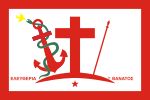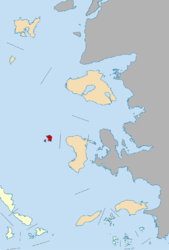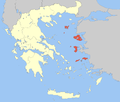Psara
Psara
Ψαρά | |
|---|---|
 Psara, Black Ridge | |
 Flag | |
 Psara show Location within the region | |
| Coordinates: 38°33′N 25°34′E / 38.550°N 25.567°ECoordinates: 38°33′N 25°34′E / 38.550°N 25.567°E | |
| Country | Greece |
| Administrative region | North Aegean |
| Regional unit | Chios |
| Area | |
| • Municipality | 44.511 km2 (17.186 sq mi) |
| Highest elevation | 512 m (1,680 ft) |
| Lowest elevation | 0 m (0 ft) |
| Population (2011)[1] | |
| • Municipality | 458 |
| • Municipality density | 10/km2 (27/sq mi) |
| Time zone | UTC+2 (EET) |
| • Summer (DST) | UTC+3 (EEST) |
| Postal code | 82x xx |
| Area code(s) | 22740 |
| Vehicle registration | ΧΙ |
| Website | www.dimospsaron.gr |
Psara (Greek: Ψαρά, Psará, [psaˈra]; known in ancient times as Ψύρα/Ψυρίη, Psyra/Psyriē) is a Greek island in the Aegean Sea. Together with the small island of Antipsara (Population 4) it forms the municipality of Psara. It is part of the Chios regional unit, which is part of the North Aegean region. The only town of the island and seat of the municipality is also called Psara.[2]
Psara had 448 inhabitants according to the 2011 census. It has a small port linking to the island of Chios and other parts of Greece.
Geography[]
Psara lies 81 km (50 mi) northwest of Chios, 22 km (14 miles) from the northwestern point of the island of Chios and 150 km (93 mi) east-northeast of Athens. The length and width of the island are about 7 by 8 km (4 by 5 mi) and the area is 43 km2 (17 sq mi). The highest point on the island is "Profitis Ilias" (512 m (1,680 ft)). The municipality has total area of 44.511 km2 (17.186 sq mi).[3]
Flag[]
The flag of Psara today is based largely on the island's famous revolutionary flag created by Psariot locals in 1824. The original flag is made of white cloth bordered with red; it bears the symbols of Filiki Eteria in red (a large cross atop a crescent, a spear, and an anchor); wrapped around the anchor is a green snake. Written in red capital letter above the cross and broken up by it is the islands name, ΨΑΡ–ΡΑ. On either side of the Filiki Eteria symbols, in red capital letters, are the words ΕΛΕΥΘΕΡΙΑ Η ΘΑΝΑΤΟΣ (Eleftheria i Thanatos, 'Liberty or Death').[4][5] The modern flag uses a very similar design but omits the island's name from the top and has added a yellow bird flying near the mouth of the snake.[6] The flag was carried during the War of Independence by Psariot ships.[7]
An original 1824 flag of Psara is preserved at the National Historical Museum of Greece.[4]
History[]
It has been inhabited since the Mycenaean period, its inhabitants relying on the sea to make a living as the island is treeless and rocky with little shrubbery.
Homer, Strabo, Cratinus, Suda and Stephanus of Byzantium referred to the island as Psyra (Ancient Greek: Ψυρά and Ψύρα)[8][9][10][11][12] and Psyrian (Ancient Greek: Ψυρίαν).[11] The island had a city also called Psyra.[9][13]
The islanders' sole source of livelihood has always been fishing, mainly for the locally abundant slipper lobsters, and shipping, with some tourist development in recent years.
There was a proverb which was used: Psyra celebrating Dionysos (Ancient Greek: Ψύρα τὸν Διόνυσον ἄγοντες).[10][11] Because Psyra was a poor and small island which could not produce wine, the proverb used in reference to people who were reclining at a symposium but not drinking. It was also used to things which displayed poverty.[10] Another proverb about Psyra was also used in order to show poverty, You regard Sparta as Psyra (Ancient Greek: Ψύρα τε τὴν Σπάρτην ἄγεις).[11]
Destruction[]

Psara joined the Greek War of Independence on April 10, 1821. Future Prime Minister Konstantinos Kanaris and Dimitrios Papanikolis distinguished themselves as naval leaders, using fire ships to combat the more powerful Ottoman Navy.
On July 3 (June 21 O.S.), 1824, the island was invaded by the Turks. The resistance of the Psariots ended the next day with a last stand at the town's old fort of Palaiokastro (alternative name Mavri Rachi, literally "black ridge"). Hundreds of soldiers and also women and children had taken refuge there when an Ottoman force of 2000 stormed the fort. The refugees first threw a white flag[14] with the words "Ἐλευθερία ἤ Θάνατος" ("Eleftheria i Thanatos", "Freedom or Death"). Then, the moment the Turks entered the fort, the local lit a fuse to the gunpowder stock, in an explosion that killed the town's inhabitants along with their enemies — thus remaining faithful to their flag to their death. A French officer who heard and saw the explosion compared it to a volcanic eruption of Vesuvius.
A part of the population managed to flee the island, but those who did not were either sold into slavery or killed. As a result of the invasion, thousands of Greeks met a tragic fate. The island was deserted and surviving islanders were scattered through what is now Southern Greece. Theophilos Kairis, a priest and scholar, took on many of the orphaned children and developed the famous school the Orphanotropheio of Theophilos Kairis. Psara remained in the hands of the Ottomans until it was recaptured by the Greek navy on 21 October 1912 during the First Balkan War.
The destruction of Psara by the Ottomans was conducted in retaliation for the destruction of Turkish ships by revolutionaries Konstantinos Kanaris and Dimitrios Papanikolis. It inspired the poet Andreas Kalvos to write the ode "To Psara" (Greek: "Εἰς Ψαρά"); perhaps more famously, the event also inspired the poet Dionysios Solomos — the author of the Hymn to Liberty — to write in 1825 a poem (or epigram) about it called "The Destruction of Psara" (Greek: "Ἡ καταστροφὴ τῶν Ψαρῶν"):[15][16]

'Στῶν Ψαρῶν τὴν ὁλόμαυρη ράχη
Περπατῶντας ἡ Δόξα μονάχη.
Μελετᾷ τὰ λαμπρὰ παλληκάρια,
Καὶ 'ς τὴν κόμη στεφάνι φορεῖ
Γινομένο ἀπὸ λίγα χορτάρια
Ποῦ εἰχαν μείνῃ 'ς τὴν ἔρημη γῆ.
On the all-black ridge of Psara
Glory walks by herself taking in
the bright young men on the war field
the crown of her hair wound
from the last few grasses left
on the desolate earth.
Historical population[]
| Year | Population | Difference |
|---|---|---|
| 1824 | 7,000[17] | |
| 1951 | 700 | |
| 1961 | 576 | - 17,71% |
| 1971 | 487 | - 15,45% |
| 1981 | 460 | - 5,54% |
| 1991 | 438 | - 4,78% |
| 2001 | 422 | - 3,65% |
| 2011 | 446 | + 5,69% |
Notable people[]

- Ioannis Varvakis (1745–1825), admiral, caviar merchant and benefactor.
- Nikolis Apostolis (1770–1827), admiral.
- Dimitrios Papanikolis (1790–1855), admiral.
- Konstantinos Kanaris (1793/1795–1877), admiral and politician, Prime Minister of Greece.
- Garafilia Mohalbi (1817–1830), Greek-American refugee and former slave.
- George Sirian (1818–1891) Gunner United States Navy
See also[]
- List of settlements in the Chios regional unit
- Masada (a similar heroic mass suicide in Jewish history)
References[]
- ^ Jump up to: a b "Απογραφή Πληθυσμού - Κατοικιών 2011. ΜΟΝΙΜΟΣ Πληθυσμός" (in Greek). Hellenic Statistical Authority.
- ^ "ΦΕΚ B 1292/2010, Kallikratis reform municipalities" (in Greek). Government Gazette.
- ^ "Population & housing census 2001 (incl. area and average elevation)" (PDF) (in Greek). National Statistical Service of Greece.
- ^ Jump up to: a b Σημαία των Ψαρών, Επανάσταση 1821 (Αρ. κατ. 1752) [Flag of Psara, Revolution of 1821 (Catalogue Num. 1752)]. Εθνικό Ιστορικό Μουσείο (in Greek). Archived from the original on 2014-09-25. Retrieved 2020-05-01.
- ^ Murgescu, Mirela-Luminita; Koulouri, Christina, eds. (2005). "National Ideologies". Nations and States in Southeast Europe (PDF). Thessaloniki: Center for Democracy and Reconciliation in South-Eastern Europe. p. 99. ISBN 960-86857-4-5. Archived from the original (PDF) on 2010-05-09.
- ^ Sache, Ivan (2015-08-10). "Psara (Municipality, Greece)". www.crwflags.com. Retrieved 2020-05-02.
- ^ "Η Ελληνική Σημάια", (The Greek flag) - Hellenic Army General Staff, Page 11, Image 14:[1] Archived 2016-03-27 at the Wayback Machine
- ^ Homer, Odyssey, §3.148
- ^ Jump up to: a b Strabo, Geography, §14.1.35
- ^ Jump up to: a b c Suda Encyclopedia, §psi.155
- ^ Jump up to: a b c d Stephanus of Byzantium, Ethnica, §Ps703.2
- ^ Agelarakis A., "Report on the Main Burial of the Mycenaean Human Skeletal Remains excavated from Archontiki Site, Psara, Greece", OSSA 13 (1986-87): 3-11.
- ^ Pliny. Naturalis Historia. 5.36.
- ^ "Typos, Cyprus newspaper". Archived from the original on 2018-10-03. Retrieved 2009-05-31.
- ^ Jerome Rothenberg, Jeffrey Robinson (2009). Poems for the Millennium, Volume Three. University of California Press. p. 358. ISBN 978-0-520-25598-2.
- ^ Solomos, Dionysios (1901). Ἄπαντα τὰ εὑρισκόμενα (in Greek). Kostis Palamas (prologue). Athens: P.D.Sakellarios. p. 99. At the Anemi digital library.
- ^ Finlay, George. History of the Greek Revolution and the Reign of King Otho (edited by H.F. Tozer). Oxford: Clarendon Press, 1877 (Reprint: London 1971), ISBN 978-0-900834-12-7, p. 152.
External links[]
- https://web.archive.org/web/20070611074035/http://www.chios.com/island/psara.htm (also in German and Greek)
- http://www.sansimera.gr/archive/articles/show.php?id=156&feature=H_katastrofi_ton_Psaron[permanent dead link] (The destruction of Psara, in Greek)
- http://www.ptolemais.com/shmaies/epanastatimena.htm (The flags of the rebellious islands (Psara), in Greek)
- Psara
- Populated places in Chios (regional unit)
- Municipalities of the North Aegean
- Landforms of Chios (regional unit)
- Islands of the North Aegean



